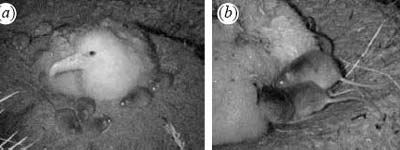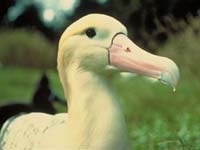
![]() As Charles Darwin learned several centuries ago, islands are havens for evolution. Newcomers to these isolated worlds find themselves unshackled from the predators that dogged them on the mainland. They celebrate their freedom by diversifying into a great variety of species. But predators still have ways of tracking them down, and following the footsteps of sailors is one of them. By killing adults and eating eggs, introduced predators such as rats, cats and stoats are responsible for nine in ten of the bird extinctions since 1600.
As Charles Darwin learned several centuries ago, islands are havens for evolution. Newcomers to these isolated worlds find themselves unshackled from the predators that dogged them on the mainland. They celebrate their freedom by diversifying into a great variety of species. But predators still have ways of tracking them down, and following the footsteps of sailors is one of them. By killing adults and eating eggs, introduced predators such as rats, cats and stoats are responsible for nine in ten of the bird extinctions since 1600.
 Now, conservation agencies are getting serious about introduced predators. As an example, they have spent increasingly large budgets in recent years on the eradication of rats from troubled islands. Smaller stowaways like mice typically escape the conservationists' wrath, and between 2001 and 2005, twenty-five times less money was spent on dealing with them. After all, mice are smaller and less opportunistic than rats and pose very little threat to seabirds.
Now, conservation agencies are getting serious about introduced predators. As an example, they have spent increasingly large budgets in recent years on the eradication of rats from troubled islands. Smaller stowaways like mice typically escape the conservationists' wrath, and between 2001 and 2005, twenty-five times less money was spent on dealing with them. After all, mice are smaller and less opportunistic than rats and pose very little threat to seabirds.
Or at least that was what scientists used to think. In 2005, Ross Wanless, Peter Ryan and colleagues from the University of Cape Town found that on Gough Island in the south Atlantic, mice had developed sinister appetites. They were eating the chicks of local seabirds alive (see image below).

House mice were introduced to Gough Island, now a World Heritage Site, in 1888 and are the only introduced mammals there. They share the island with large seabird colonies including many endangered species, and the last breeding populations of the Tristan albatross and the Atlantic petrel.
The mice seemed to be co-existing peacefully until the turn of the millennium, when some of the seabirds started experiencing massive breeding losses. Wanless investigated and by watching about 300 nests, he found video evidence that the mice have developed a taste for albatross, petrel and shearwater chicks. They were attacking and eating chicks up to 300 times their weight, and often en masse.
Albatross chicks are not defenceless and will often ward off much larger avian hunters like the sub-Antarctic skua or the southern giant petrel. But they have also been spoilt through an evolutionary history free of mammalian dangers. The chicks have no idea how to react to mice, let alone defend themselves - hapless and helpless.
 In fact, Wanless describes the mice as parasites rather than predators. They often don't kill the chicks outright but slowly feed from open wounds over the course of days.
In fact, Wanless describes the mice as parasites rather than predators. They often don't kill the chicks outright but slowly feed from open wounds over the course of days.
Typically, 60-75% of Tristan albatross young survive their first year. But thanks to the voracious mice, only 27% now do so on Gough Island. As a result, the population of this already vulnerable bird has crashed by over a quarter since the 1960s.
The birds of Gough Island will clearly need some assistance. Meanwhile, Wanless is sounding the alarm for other islands where introduced mice roam free. On islands where they are not alone, larger introduced predators like cats or rats may be helping to keep their numbers down. The danger then, is that when conservationists get rid of these larger problems, they may unwittingly unleash a smaller foe on the native animals.
This very situation seems to be playing out on Marion Island in the South Indian Ocean. In the 1990s introduced cats were finally eradicated from the island, leaving mice as the only mammal aliens around. And sure enough, Ryan has found that several wandering albatross chicks have died of wounds consistent with mouse attacks. These attacks could be much more widespread than we had realised.
The message is clear - eradication programmes for introduced animals should target all potential predators, whether big or small. As in the case of sharks and scallops dealt with elsewhere in this blog, the removal of top predators can often doom animals at the bottom of the food chain by releasing hunters in the middle tier.
Reference: Wanless, Angel, Cuthbert, Hilton & Ryan. 2007. Can predation by invasive mice drive seabird extinctions? Biology Letters doi:10.1098/rsbl.2007.0120
More on introduced/displaced predators:


Very say.
Thanks for the information.
Dan Howitt
Damn mice, those birds look pretty cool. Though I suppose mice have it pretty bad in this world. We use them for experiments, they're seen as pests and killed, etc... so I guess it's about time they get some quality food.
An example of cultural evolution perhaps? Like the tits that learned to open milk bottles or macaques that wash potatoes. This is a very disturbing example, however.
Hm!
I'm reminded of the hypothesis that mammals helped to kill off the dinosaurs by eating their eggs. Might they have also turned to opportunistic munching of hatchling dinos?
And of course, birds are dinosaurs...